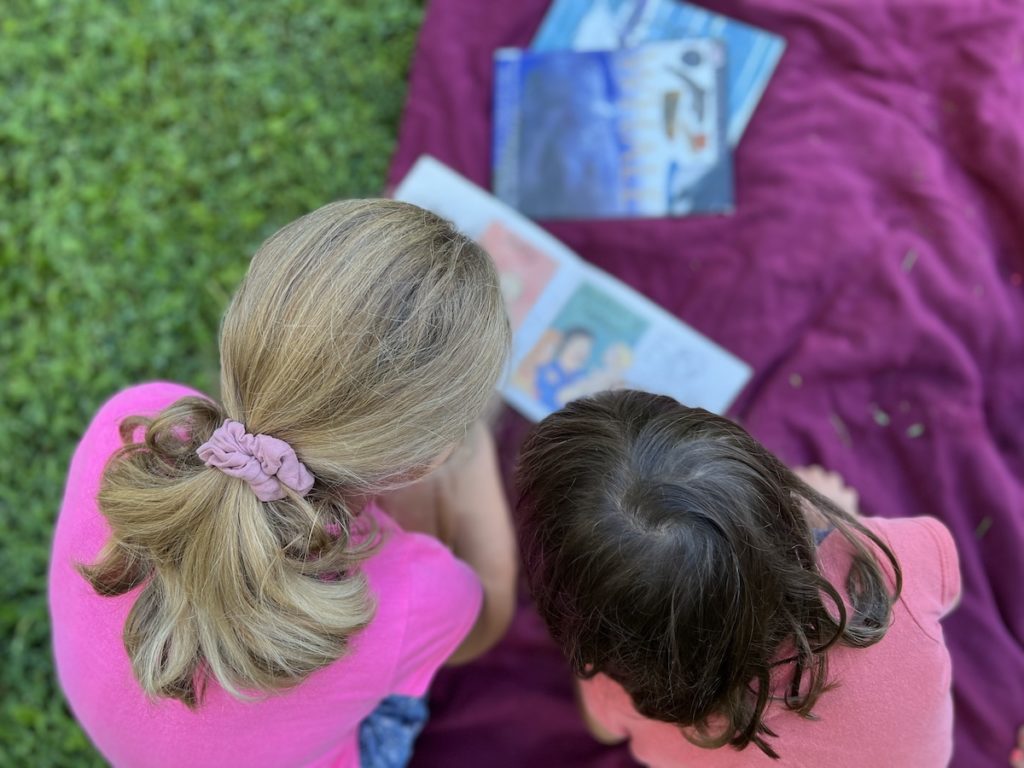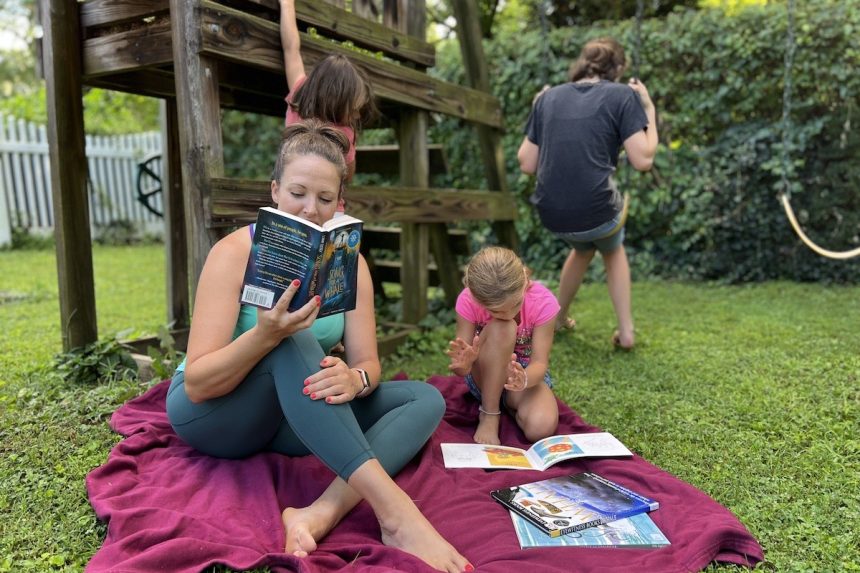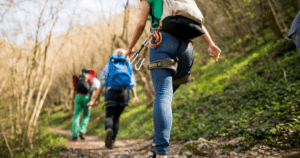“How can I homeschool without curriculum?”
I get asked this a lot.
“If I leave boxed curriculum behind, how can I be sure we are fitting everything in?”
“How will my children get what they need and not fall behind?”
First of all, there is no “right” way to learn. Learning is dependent on the learner and each of us in unique. That is a larger conversation around deschooling.
You can homeschool without curriculum, naturally and on the fly.
Here is a prime example ripped straight from the pages of my family’s life. We are reading a wonderful book called Song for a Whale by Lynne Kelly. It was a quick grab from the display shelf at our local library as you walk-in. It took precisely the first 2 pages before we were all hooked: the 14-year-old, the 8-year-old, the 4-year-old, and the mama (who remains delightfully ageless *cough, wink*).
It’s an enchanting, highly relatable chapter book about a deaf girl named Iris and her fascination with a whale, Blue 55, who has a different song than any other whale in the ocean. It’s a story about loneliness and feeling like you’re the only one. It’s also a tale about learning to be okay with being yourself.
Since the main character, Iris, is completely deaf, there is an immediate and fantastic opportunity to grow empathy and understanding. These opportunities to imagine what it must be like to be hearing impaired or deaf is a wonderful social emotional exercise for readers to grasp what differences and struggles other people have that are similar and dissimilar to their own.
Great book recommendation. But where do I go from here?
How do I homeschool without curriculum?

First, start reading.
Inside the first 30 pages I’d learned several critical facts to the story. These facts allowed me to pull together resources to enrich and expand the story line for greater comprehension and knowledge.
- Iris is deaf. She attends a public school with an interpreter who signs for her.
- Iris does not belong to a community of deaf people and lip reading is a struggle. Words sound the same but mean different things, by the time she has the right word, the conversation has moved on.
- Blue 55 is a baleen whale, a hybrid cross between a gray whale and a fin whale. His song is not understood by other whales, this communication barrier prevents his belonging in a whale pod.
- Though deaf, repairing antique radios is Iris’ passion and hobby.
Second, check out your library catalog for keywords pulled from your read aloud facts and check them out!
- Sign language
- Homophones
- Whales
- Antique radios
Why just books at this stage?
Books are invitational and illustrative accessories to the read aloud. Books are a great supplement because they are always available (access-wise). They are quick to grab and delve into while the read aloud is happening or other times, when a learner gets curious. Get a wide variety to choose from, such as easy readers, references, biographies and picture books. Children will have a feast to choose from – some may be read or just flipped through – trust they will absorb what they need. I’m often surprised by how much kids choose to explore when it’s on their terms.

Here is the list of books we borrowed locally based on our key words:
- Signing at School by S. Harold Collins
- Signing Made Easy by Butterworth and Flodin
- Simple Signs by Cindy Wheeler
- Homophones Visualized by Bruce Worden
- Baby Whales Drink Milk by Barbara Juster Esbensen
- DK Eyewitess Books Whale
- The Spirit of Springer: the real-life rescue of an Orphaned Orca by Amanda Abler
- Old Time Radios! Restoration and Repair by Joseph Carr
Every volume listed has pictures or illustrations, first and foremost these will illuminate concepts from the illustration-less read aloud. Specifically, the signing books help children visualize sign language that happens in the read aloud. They also invite kids to try signing for themselves.
Homophones Visualized is a great grammar lesson but also helps children understand the complexities of lip reading. Homophones are words that are spelled differently but sound the same (ie. bare and bear). This book is a fun and informative read. Most importantly it illustrates to children how difficult reading lips can be: trying to identify words and their meaning by how someone shapes them in their mouth while keeping pace with the conversation.
In the whale books, children can see pictures and learn more about whale life cycles, habitats, species, etc. The Spirit of Springer is a biography of a whale rescue with many similarities to Song for a Whale. This book launched us in further reading online about Springer, hydrophones, conservation, geography of the Pacific coast of North America and You-Tube tutorials on making our own hydrophone as well as listening to live and recorded whale calls on sites like this and this.
Finding a book on radio restoration and repair seemed serendipitous! Again, I chose this for my children to look at, flip through and gain a visual of what old radios look like. However, there’s some interesting things my 14-year-old has learned and pulled from it.

Finally, stay intuitive and flexible as you continue to read and see opportunities to enhance learning.
This might look like:
- An internet search
- A YouTube session
- Watching a movie like Free Willy, the Miracle Worker. Older kids/parents may try The Silent Child.
- Playing an instrument, your voice or whistle with an oscilloscope app
- Finding an experiment about sound waves to try – tin can phone, anyone?
- Reading about the real-life whale, Blue 52, the book was based on
- Learning more about hearing impaired people and/or sign language
When you homeschool without curriculum it illustrates the intersectionality natural learning takes across many typical ‘school’ subjects that you may otherwise find in isolation in a traditional curriculum. Natural learning leaves the direction taken to the learner, not the curriculum writers.
PS – the learner is your whole family, including you.
When entire family is engaged in a read aloud, the other books and activities appeal to every individual differently, based on age and interest. This allows each person to explore more of what fascinates them and then naturally share findings with each other in conversation (a natural form of narration). Narration is passing verbal or written knowledge onto another person and by doing so, the narrator’s learning deepens.
To close, I wanted to leave you with a list of the subjects/skills that were contained in this study:
- Reading
- Writing
- History
- Geography
- Science
- Conservation
- Ethics
- Math
- Music
- Social Emotional Studies
I encourage you to try out this approach! Especially the next time you are in a tough place, struggling with overwhelm, or burn out. Take a break from everything that is fueling that and pick up a new read aloud. Get a whole bunch of them and try them out one at a time – if it isn’t engaging everyone, quit and move on – there are so many great books out there!
When you do find a book that captures the imagination of your children and yourself, start thinking as you read – what are the main themes and facts that you can pull the thread on. Use what you have in your home, go online, utilize the library and lay out these extra resources for your kids to dig into. Have fun learning alongside your children, slow things down and wander down the rabbit holes. Following their interests shows your children that they are worthy, just the way they are – they belong. It’s a powerful way to protect their identity and encourage authenticity.
See? You can homeschool without curriculum.
Check out our other free and paid resources here.
Happy homeschooling!




